My experience with foreign journalists is, in short, the following: Prior to 2008 they came to hear about the extraordinary boom, 2009 – 2010 they came to hear about the extraordinary bust, then about the recovery, then euro introduction and the fifth and current wave of journalists wants to hear about Latvian lessons for Greece.
I have to tell them that there is nothing much Greece can learn, unless it were able to turn back the clock several years. Rather, it is Latvia that can learn a bit from Greece.
In the following I deal with ten differences or similarities between Latvia and Greece. It may not be an exhaustive list but all items should be relevant. I could also have added more discussion but this is a blog/column, not an article. In short, I have chosen to let the data speak with myself adding a few comments. Most graphs start in 2002 – the year when Greece entered the Eurozone and when the boom had gotten underway in Latvia. I put this analysis into three parts, mostly to adhere to the idea that a blog should not be too long. This part I (on GDP and unemployment) will thus be followed by a part II (mostly on fiscal policy) and a part III (other indicators and overall conclusions).
Figure 1: Annual growth rates in Greece and Latvia, 2002 – 2014
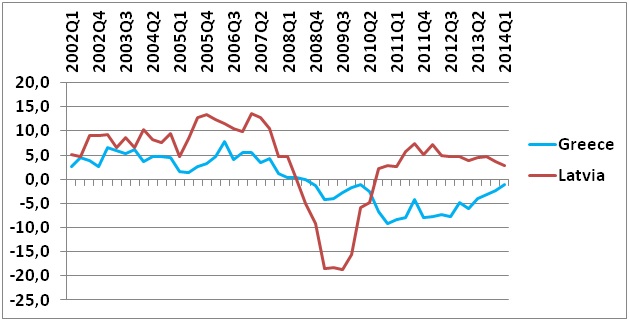
Source: Eurostat
1) The big Latvian boom ended in the 2nd quarter of 2008, turned into a massive recession which was, however, relatively short and ended exactly two years later. Greece turned into recession a quarter later than Latvia but was still in recession in Q2 2014, the latest data provided by Eurostat. That is 23 successive quarters of recession, which make the Latvian eight pale by comparison (Note: Eurostat has been rather slow with growth updates – Greece should have turned to positive growth by the end of 2014 but then slipped into recession again in 2015).
Figure 2: Cumulative GDP development, 2007 = 100
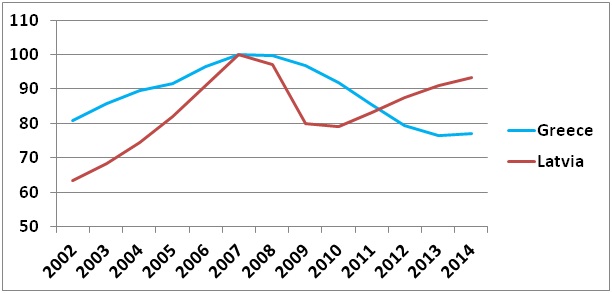
Source: Eurostat and own calculations
This development is confirmed in Figure 2. In about two years Latvia lost some 21% of GDP but it has since regained most of this loss and is now 7% below the peak of 2007. Greece’s cumulative loss is 23% and counting…. In short, two countries with massive GDP declines but one, Latvia, with a short, ultra-sharp recession and one, Greece, with an ultra-prolonged slow-motion train wreck.
2) This very different development is repeated by unemployment numbers, see Figure 3. Latvian unemployment took a sharp rise, then fell again with growth picking up and migration. Greek unemployment kept surging as GDP kept falling. There is talk – and numbers – of Greek migration but obviously not enough to seriously dent the unemployment figures yet.
Figure 3: Unemployment rates in Greece and Latvia, 2002 – 2014
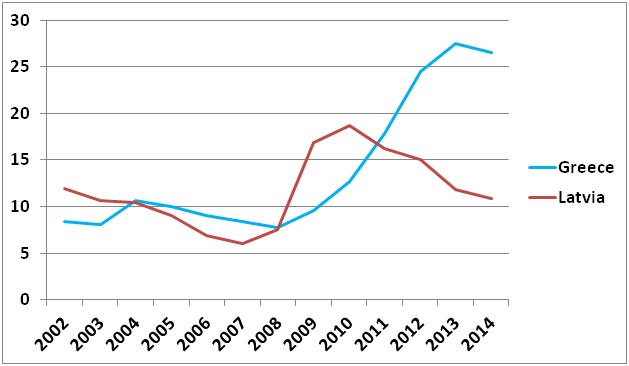
Source: Eurostat
3) Over the years, Latvia has closed a substantial part of the gap in terms of GDP per capita. In 1992, Latvian GDP per capita was a paltry 40% of the Greek level; today it is 92%, partly due to recession in Greece but mostly due to reforms leading to a partial catching-up, as is seen in Figure 4. This is not the place for a deep discussion of reforms but Latvia has improved its rankings over the years in e.g. the World Economic Forum’s Global Competitiveness Report where it is now number 42 in the world, just behind Lithuania and just ahead of Poland with Greece at a rather dismal 81st place, just ahead of Moldova. In short, Latvia looks healthier in a structural sense which should bode well for future GDP, when compared to Greece.
Figure 4: GDP per capita, USD, Greece and Latvia, 1992 – 2014
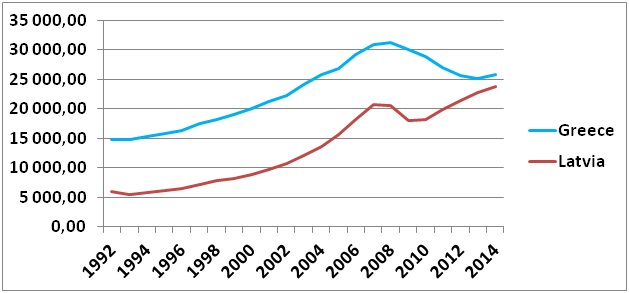
Source: IMF
Another way to look at this is in Figure 5 – at 64% Latvian GDP per capita is still 36% below the EU average but has increased from just 45% in 2003; a partial convergence, whereas Greece’s has diverged from the EU average and now stands at just 72% of the EU average, behind e.g. Lithuania and Estonia.
Figure 5: GDP per capita in Greece and Latvia, GDP per capita in EU28 = 100
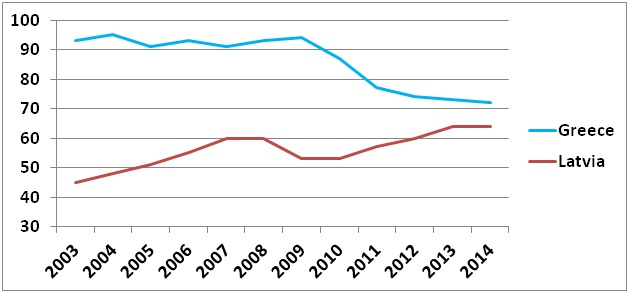
Source: Eurostat
Conclusions, part I
a) Similar GDP declines but at very different paces. Fast and ultra-deep in Latvia, slow and never-ending in Greece. Latvia has grown for five years since the recession; Greece hasn’t started yet.
b) Latvia has made substantial catching-up during the past decade (and not least the past two decades), while Greece has slipped considerably.
I shall in no way downplay the severity of the recession in Latvia but it must be very agonizing to have a recession like the Greek one that just grinds on and on and on – in such circumstances, who wants to invest? In fact, nearly no-one – only a dismal 12% of an already 23% lower GDP goes to investment , something that might not even be enough as replacement investment for worn-out capital goods and something which will therefore have a detrimental effect on future Greek GDP. The Latvian figure is a respectable but still not satisfactory 21% of GDP.
Part II of this comparison will be about the role of fiscal policy in the two countries.
Morten Hansen is Head of Economics Department at Stockholm School of Economics in Riga and a member of the Fiscal Discipline Council of Latvia






Komentāri (10)
Aivars 23.07.2015. 18.07
Tik tālu gluži kā par to astes nociršanu kaķim,Latvija ar vienu cirtienu,Grieķija pa mazam gabaliņam.Un šobrīd Grieķija pēc visas mocīšanās tik un tā spiesta sākt straujas,sāpīgas reformas.Tikmēr Latvijas ekonomika ataug (tas salīdzinājums ar asti vairs nestrādā:))Interesanti būs salīdzināt vēl pēc dažiem gadiem,domāju rezultāti būs līdzīgi,tikai grieķi līdz 2015.g. zaudēja laiku.
0
Neticis 23.07.2015. 20.03
Morten, I’d recommend to use “Annual changes” instead of “Annual growth” in label of Figure 1. Otherwise I have to suspect you are also follower of “Infinite growth (at least for GDP dollars) in finite world” idea.
0
Artūrs 25.07.2015. 19.01
How much can this attributed to Latvia having much lower debt to gdp before crisis?
How much can this be atrributed to latvia returning to financial markets with ultra-low interest rates and taking into account this wasnt possible in Greece.
How much is taken into account that around 10percent of population have left, lifting gdp per capita.
And now that LAtvia is in eurozone and that chronic current account deficit and nearly the same economic model how safe it is to assume Latvia will become the next Greece when the business cycle turns round in 5-10years time ?
0